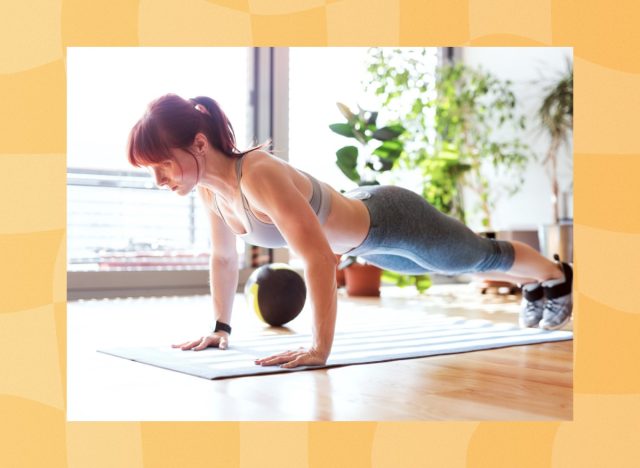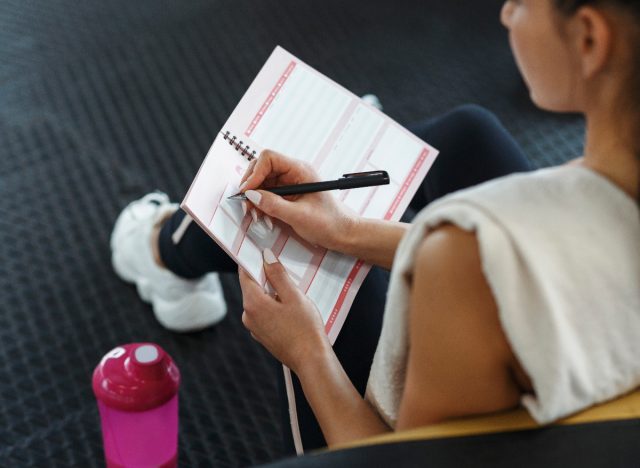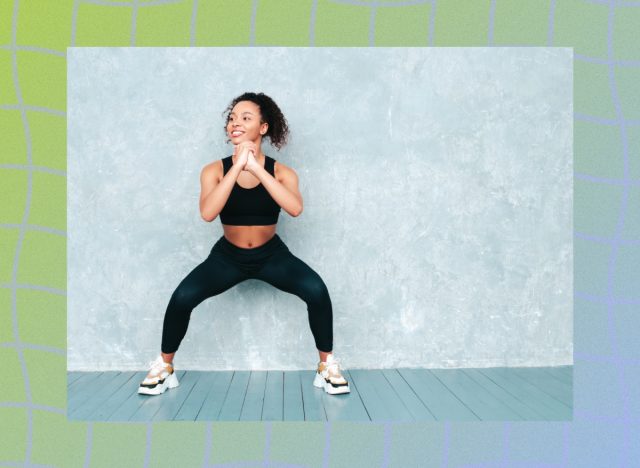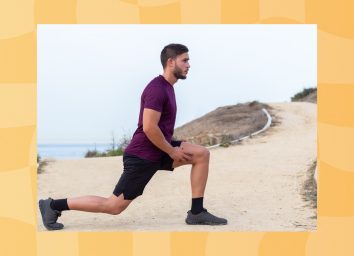The Secret Trick for Getting Fit Using Your Toothbrush

Saara Haapanen, BSc, MSc, a Ph.D. candidate, personal trainer, and performance consultant for the Colorado Governor's Council for Active and Healthy Lifestyles, once explained to us at ETNT Mind+Body the merits of "habit stacking," a healthy lifestyle hack that requires you to group together two-or-more habits into one in your routine. As example of shrewd habit stacking, she recommended you "do 15 squats after you brush your teeth."
After all, the thinking goes, you're going to be brushing your teeth anyway, and by bundling in some squats every time you clean your teeth—and by programming your mind to associate physical activity with such a perfunctory task—you're going to end up doing a lot more squats. (For more on why doing more squats is a good thing, don't miss What Doing Squats Does to Your Body, According to Science.)
However, according to previous studies—and a new article published in The New York Times—this little lifestyle hack is far more powerful than we knew, and applying its underlying principle to all sorts of habits you do every day beyond simply brushing your teeth—whether it's watching TV, commuting, brewing your morning coffee, or even powering down your computer—will boost your chances of becoming a fitter, healthier person. Curious to know more? Read on for more on the power of pairing together fitness activities and other things in your daily routine. And for more great exercise advice, don't miss The Secret Exercise Trick for Flatter Abs After 40.
Bundling Tasks Creates Iron-Clad Cues As a Get-Fit Reminders

As Katy Milkman, Ph.D, professor at the Wharton School and author of How to Change: The Science of Getting From Where You Are to Where You Want to Be, explained to The NY Times, one of the best ways to see through your goals is to "create specific cues to remind you of your goals."
"Vague intentions are easy to put off," Milkman explained. "If you make a vague plan to exercise more, and you're feeling lazy, you can tell yourself, 'I still plan to exercise, and I'll do it later.' But cue-based plans are harder to put off."
In other words, if your goal is to do 100 pushups-a-day and your cue to do them is "when you enter your kitchen to eat," you're far more likely to actually do those pushups. For more some great workouts to try, learn why These 5-Minute Exercises Will Make You Sleep Like a Teenager.
Pairing Fitness with Things You Enjoy Doing Works

It's called "temptation bundling." As an example, one study published in the Journal of Consumer Research observed children who were forced to study and do schoolwork. The researchers discovered that those who were allowed to listen to music and snack while studying got more done than those who didn't.
"One example of temptation bundling might be to watch a favorite show, like Bridgerton, while you walk on a treadmill," writes the Times.
"People have the wrong mental model of how to achieve a tough new goal," observed Milkman. "They think they have to push through something they don't like, but people do better if they pursue a new goal in the most fun way possible."
If you're committing yourself to doing squats every time you dine at a 5-star restaurant, this won't work. But if it's a healthy habit you're applying more broadly to "dinner," studies show that you'll drastically raise your chances of actually doing it.
It's Helpful to Be Very Specific with Your Planning

The Times article references one study published in The British Journal of Health Psychology that "showed that people were twice as likely to follow through on a goal if they made a plan for a time and place to start doing it." For the study, a group of exercisers who were forced to plan exactly when and where they would be working out were drastically more likely to follow through with the exercise than those who didn't.
So if you'd like to make an exercise routine more routine, you need to get very specific about when, where, and how you're doing to do it. Don't be so vague as to say, "I'm going to exercise tomorrow sometime." Commit to "Tuesdays at 2:30pm after my team call." When you shut down Zoom? It's your cue.
Here Are Some Great Ways to Habit Stack

Yes, you can start by performing exercises while you brush your teeth. But there are countless cues you can rely on to get moving. "For example, when you finish work for the day and turn your computer off, that may be your behavioral cue to exercise, which allows you to fit this in prior to eating dinner, which is your time cue," Dr. Charlotte Chandler, senior lecturer in sport and exercise psychology at the University of Derby, explained to Stylist.
Other examples include running in place while you're coffee is dripping, doing calf raises while you wait for the shower to warm, and doing pushups while your food is in the microwave.
And if this doesn't sound like worthwhile fitness to you, know that you're wrong. A body of research is emerging that touts the benefits of "exercise snacking," which is defined as doing micro-bouts of exercise throughout your day that doesn't take much time but on the whole constitutes a great workout. According to a study published earlier this year in the Journal of Applied Physiology, performing a two-minute walk—or doing a quick set of exercises such as squats—can offset the effects of a half-hour of sitting. Another study, published in the journal Medicine & Science in Sports & Exercise, found that going hard for just four seconds may significantly increase your cardiovascular fitness levels and increased muscle mass. And for more life-changing exercise advice, see here for the Secret Exercise Tricks for Keeping Your Weight Down for Good.








